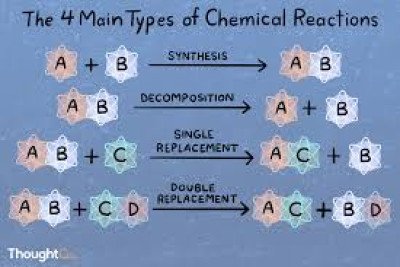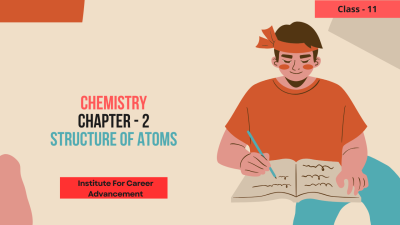Course description
Have you ever wondered why some fires blaze out of control while others smolder for hours? The answer lies in chemical kinetics, the fascinating branch of chemistry explored in Class 12. This course delves into the world of reaction rates, equipping you to understand why some chemical reactions happen in a blink of an eye, while others take ages.
Speed Demons vs. Slowpokes: Unveiling the Factors
- The Rate Game: Chemical kinetics is all about reaction rates – how fast or slow a chemical reaction proceeds. This course explores the key players that influence this speed:
- Concentration: Imagine a crowded dance floor – the higher the concentration of reactants (dancing partners), the more likely they are to bump into each other and react.
- Temperature: Think of heating up the dance floor – increased temperature gives reactant molecules more kinetic energy, making them collide more frequently and react faster.
- Catalysts: These act like matchmakers, accelerating reactions by providing an alternative pathway with a lower energy barrier. (Imagine a dance instructor showing the perfect moves!)
- Activation Energy: Every reaction requires a minimum energy input to proceed – the activation energy. Understanding this helps explain why some reactions occur readily, while others need a jumpstart (like a spark to ignite a fire).
The Art of Measurement: Tracking the Reaction
Chemists don't just watch reactions happen – they measure their rates! This course equips you with the tools to quantify reaction speed:
- Concentration Changes: By tracking how the concentration of reactants or products changes over time, you can calculate the reaction rate. Imagine measuring the number of reactants disappearing or products appearing over time.
- Rate Laws: These mathematical expressions relate the reaction rate to the concentration of reactants, providing a quantitative understanding of how these factors influence speed.
Reaction Mechanisms: Unveiling the Hidden Steps
Chemical reactions aren't always one-step processes! This course introduces the concept of reaction mechanisms, which describe the detailed sequence of elementary steps that a reaction goes through. Understanding the mechanism helps explain:
- Why some reactions are slow: Multi-step mechanisms with slow or complex steps can explain why a reaction might be sluggish.
- The role of intermediates: These short-lived species, formed and consumed during the reaction mechanism, can play a crucial role in determining the overall rate.
Rates & Order: Understanding the Dance
Chemical kinetics introduces another key concept – reaction rate order. This tells you how much the reaction rate changes with a change in concentration of a specific reactant. Imagine how changing the number of dancers affects the overall collision frequency. By understanding reaction order, you can predict how changing reactant concentrations will impact the speed of the reaction.
Beyond the Basics: Kinetics in Action
Chemical kinetics isn't just about theory! This course explores its applications in various fields:
- Chemical Engineering: Optimizing industrial processes by understanding how reaction rates depend on factors like temperature and concentration.
- Environmental Science: Studying reaction rates of pollutants in the environment to develop strategies for remediation.
- Food Science: Understanding the role of kinetics in food spoilage and preservation techniques.
আপনি কি কখনও ভেবে দেখেছেন যে কেন কিছু আগুন নিয়ন্ত্রণের বাইরে চলে যায় এবং অন্যগুলি ঘন্টার পর ঘন্টা ধরে জ্বলতে থাকে? উত্তরটি রাসায়নিক গতিবিদ্যার মধ্যে রয়েছে, যা দ্বাদশ শ্রেণিতে আবিষ্কৃত রসায়নের আকর্ষণীয় শাখা। এই কোর্সটি প্রতিক্রিয়া হারের জগতে অনুসন্ধান করে, যা আপনাকে বুঝতে সাহায্য করে যে কেন কিছু রাসায়নিক প্রতিক্রিয়া চোখের পলকে ঘটে, আবার অন্যগুলি কয়েক বছর সময় নেয়।
স্পিড ডেমনস বনাম স্লোপোকসঃ ফ্যাক্টরগুলি উন্মোচন করা
হার খেলাঃ রাসায়নিক গতিবিদ্যা হল প্রতিক্রিয়ার হার-একটি রাসায়নিক বিক্রিয়া কত দ্রুত বা ধীর গতিতে অগ্রসর হয়। এই কোর্সটি এই গতিকে প্রভাবিত করে এমন মূল খেলোয়াড়দের অন্বেষণ করেঃ
মনোযোগঃ একটি জনাকীর্ণ নাচের মেঝে কল্পনা করুন-প্রতিক্রিয়াশীলদের (নাচের অংশীদারদের) ঘনত্ব যত বেশি হবে, তাদের একে অপরের সাথে ধাক্কা খাওয়ার এবং প্রতিক্রিয়া দেখানোর সম্ভাবনা তত বেশি।
তাপমাত্রাঃ নাচের তলকে গরম করার কথা ভাবুন-বর্ধিত তাপমাত্রা প্রতিক্রিয়াশীল অণুগুলিকে আরও গতিশক্তি দেয়, যার ফলে তারা আরও ঘন ঘন সংঘর্ষ করে এবং দ্রুত প্রতিক্রিয়া দেখায়।
অনুঘটকঃ এগুলি ম্যাচমেকারদের মতো কাজ করে, কম শক্তির বাধা সহ একটি বিকল্প পথ সরবরাহ করে প্রতিক্রিয়াগুলিকে ত্বরান্বিত করে। (কল্পনা করুন একজন নৃত্য প্রশিক্ষক নিখুঁত নড়াচড়া দেখাচ্ছেন!)
সক্রিয়করণ শক্তিঃ প্রতিটি বিক্রিয়ার জন্য একটি ন্যূনতম শক্তি ইনপুট প্রয়োজন-সক্রিয়করণ শক্তি। এটি বোঝা ব্যাখ্যা করতে সাহায্য করে যে কেন কিছু প্রতিক্রিয়া সহজেই ঘটে, আবার অন্যদের একটি লাফস্টার্ট প্রয়োজন। (like a spark to ignite a fire).
পরিমাপের শিল্পঃ প্রতিক্রিয়ার উপর নজর রাখা
রসায়নবিদরা কেবল প্রতিক্রিয়াগুলি ঘটতে দেখেন না-তারা তাদের হার পরিমাপ করেন! এই কোর্সটি আপনাকে প্রতিক্রিয়ার গতি পরিমাপ করার সরঞ্জাম দিয়ে সজ্জিত করেঃ
ঘনত্বের পরিবর্তনঃ সময়ের সাথে বিক্রিয়করা বা পণ্যগুলির ঘনত্ব কীভাবে পরিবর্তিত হয় তা ট্র্যাক করে আপনি প্রতিক্রিয়ার হার গণনা করতে পারেন। সময়ের সাথে সাথে অদৃশ্য হয়ে যাওয়া প্রতিক্রিয়াশীল বা প্রদর্শিত পণ্যের সংখ্যা পরিমাপ করার কথা কল্পনা করুন।
হার আইনঃ এই গাণিতিক অভিব্যক্তিগুলি বিক্রিয়াগুলির ঘনত্বের সাথে বিক্রিয়ার হারকে সম্পর্কিত করে, এই কারণগুলি কীভাবে গতিকে প্রভাবিত করে তার একটি পরিমাণগত ধারণা প্রদান করে।
প্রতিক্রিয়া প্রক্রিয়াঃ লুকানো পদক্ষেপগুলি উন্মোচন করা
রাসায়নিক বিক্রিয়া সবসময় এক ধাপের প্রক্রিয়া নয়! এই কোর্সটি প্রতিক্রিয়া প্রক্রিয়াগুলির ধারণার পরিচয় দেয়, যা একটি প্রতিক্রিয়া যে প্রাথমিক ধাপগুলির মধ্য দিয়ে যায় তার বিস্তারিত ক্রম বর্ণনা করে। প্রক্রিয়াটি বুঝতে পারা ব্যাখ্যা করতে সাহায্য করেঃ
কেন কিছু প্রতিক্রিয়া ধীর হয়ঃ ধীর বা জটিল পদক্ষেপ সহ বহু-পদক্ষেপ প্রক্রিয়া ব্যাখ্যা করতে পারে যে কেন একটি প্রতিক্রিয়া ধীর হতে পারে।
মধ্যস্থতাকারীদের ভূমিকাঃ প্রতিক্রিয়া প্রক্রিয়া চলাকালীন গঠিত এবং খাওয়া এই স্বল্পস্থায়ী প্রজাতিগুলি সামগ্রিক হার নির্ধারণে গুরুত্বপূর্ণ ভূমিকা পালন করতে পারে।
রেট ও অর্ডারঃ নাচ বোঝার
রাসায়নিক গতিবিদ্যা আরেকটি মূল ধারণা প্রবর্তন করে-প্রতিক্রিয়া হারের ক্রম। এটি আপনাকে বলে যে একটি নির্দিষ্ট বিক্রিয়কের ঘনত্বের পরিবর্তনের সাথে বিক্রিয়ার হার কতটা পরিবর্তিত হয়। কল্পনা করুন কিভাবে নৃত্যশিল্পীদের সংখ্যা পরিবর্তন সামগ্রিক সংঘর্ষের ফ্রিকোয়েন্সি প্রভাবিত করে। বিক্রিয়ার ক্রম বোঝার মাধ্যমে, আপনি ভবিষ্যদ্বাণী করতে পারেন যে বিক্রিয়কের ঘনত্বের পরিবর্তন কীভাবে বিক্রিয়ার গতিকে প্রভাবিত করবে।
মৌলিক বিষয়গুলির বাইরেঃ ক্রিয়ায় গতিবিদ্যা
রাসায়নিক গতিবিদ্যা কেবল তত্ত্ব সম্পর্কে নয়! এই কোর্সটি বিভিন্ন ক্ষেত্রে এর প্রয়োগগুলি অন্বেষণ করেঃ
রাসায়নিক প্রকৌশলঃ তাপমাত্রা এবং ঘনত্বের মতো বিষয়গুলির উপর বিক্রিয়ার হার কীভাবে নির্ভর করে তা বোঝার মাধ্যমে শিল্প প্রক্রিয়াগুলিকে অনুকূল করা।
পরিবেশ বিজ্ঞানঃ প্রতিকারের জন্য কৌশল বিকাশের জন্য পরিবেশে দূষণকারীদের প্রতিক্রিয়া হার অধ্যয়ন করা।
খাদ্য বিজ্ঞানঃ খাদ্য নষ্ট এবং সংরক্ষণের কৌশলগুলিতে গতিবিদ্যার ভূমিকা বোঝা।



















